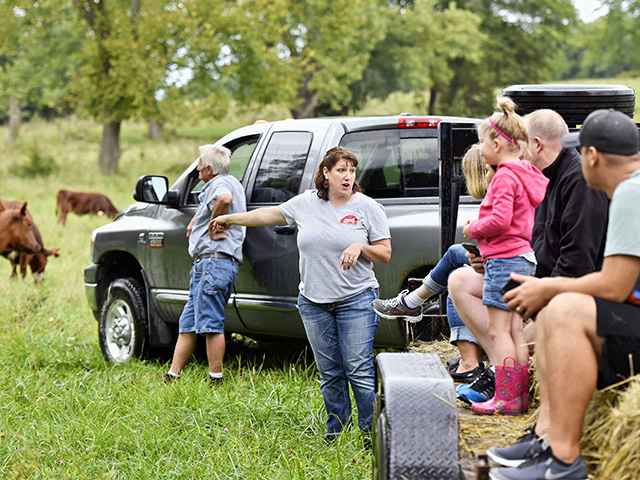Community Roundup
Agritourism - Community Roundup
Iowa beef producers Corinne and Justin Rowe never just wanted to sell beef. They wanted something more. They wanted a relationship with those buyers.
Known locally as "Rowe's Red Cows," this fifth-generation cattle family, based near Dallas Center, found an unusual way to make folks feel like family. They came up with "Moo-ve Your Beef" in 2018, an annual event that brings select customers to the farm to participate in a cattle drive. This is just moving cow/calf pairs from one pasture to another, but for folks outside of the cattle business, it's close enough to be considered a cattle drive. The Rowes give customers a visit to the farm and insight into how they handle cattle. Afterward, there's time for feedback, lots of questions and a picnic lunch.
VISITOR PLANS
Before extending invitations, the Rowes carefully evaluate their grazing setup for the season, identifying a good location where visitors will be able to observe cattle up close while experiencing the short move. They consider what size group they can manage for a particular move. Visitors are kept safe, riding on a trailer lined with hay bales, as cattle are moved.
During this drive, eight adults and one child take part in a one-mile move that lasts between 15 and 20 minutes, starting at 4 p.m. The Rowes work out as many details as possible beforehand, informing neighbors about the event and fencing off the route to prevent cattle from straying off course.
P[L1] D[0x0] M[300x250] OOP[F] ADUNIT[] T[]
When visitors arrive, they are told what is about to happen and how to respond if a cow goes under a fence or something equally unexpected happens.
"We explained that, for their safety, we had a designated area where they needed to stay," Corinne says. "We asked them to follow our lead if something went wrong. After they observed the cows and calves close up in the paddock for a few minutes, we got ready to start our move."
The Rowes stationed a pickup on the south and north end of the move route to help keep cattle on the intended path. Justin opens the pasture gate to the road and leads cattle out with a four-wheeler. Corinne follows, making sure no one gets left behind. "Both I and one of our helpers followed the cattle to make sure we didn't have stragglers and none of the cows turned into a yard along the way," she explains.
OBSERVATIONS
As they herd the cattle along, the Rowes talk to them, saying things like, "Come on, girls. Keep moving." They learn later their verbal coaching surprised their guests.
"They couldn't figure out why we talked to the cows," Corinne laughs. "But, we always talk to them."
The move ends with time for visitors to observe how cattle begin grazing immediately after entering a new paddock. Poly water tanks are moved and set up in the new grazing area. It is a normal day in a cattle producer's life, but for someone who has never been on a ranch, it is a new experience.
The afternoon concludes with grilled burgers underneath a large Maple tree, where the Rowes make time to answer questions about the operation.
And, as is often the case when dealing with cattle, there is at least one surprise this first year. "We didn't plan to have a newborn calf for visitors to see, but there was an hours-old calf," Corinne says. "They were all able to see and take pictures of it. At the end of the day, we believe our customers were more confident than ever in how we produce beef."
FOR MORE INFORMATION:
> Follow the Rowes on social media: @rowes_red_cows
[PF_0820]
(c) Copyright 2020 DTN, LLC. All rights reserved.




